Today I’m answering a question I received from one of our Dental Startup Academy readers, a doctor who’s in his own practice with multiple front desk team members – who also happens to be using Open Dental as their Practice Management System.
The doctor is asking if I can briefly go through my workflow from start to finish on how to prepare for patients that are scheduled and how to complete the day.
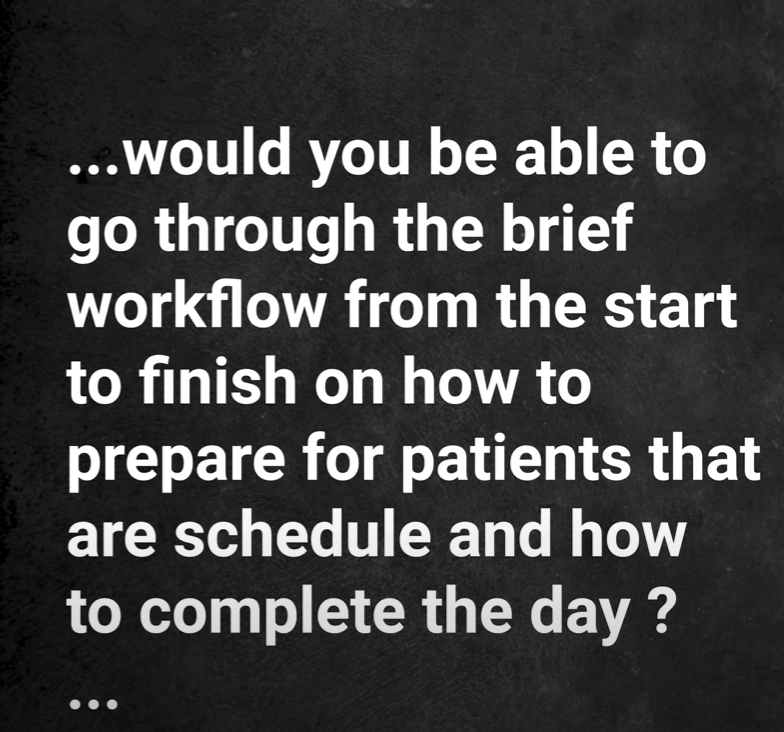
So I’m going to share exactly what the doctor is asking and show you how we approach our daily routines in my practice using Open Dental.
Whether you’ve started from scratch recently or you’re in an established practice – you’ll find these routines super helpful.
I always tell my team and when I talk to other doctors and their team members – is that the most important day is TODAY – take care of all the things you’re supposed to do TODAY.
Anythink that is skipped will result in errors, it will spill over into tomorrow, then into weeks, then months, and then years.
This is how offices end up with MULTIPLE pages of aging reports, patients that haven’t been called in months and sometimes years for recall, or patients who fall through cracks who have pending treatment etc.
So may as well do it right the first time!
So let’s go ahead and dig deeper into the problem!
I can think of 3 major reasons why there may be inefficiencies at the front desk if you’ve got multiple team members.
Lack of Accountability
The first thing I always bring up whether it’s 1, 2 or 3 front desk team – is whether or not there is any accountability among the team.
Are the expectations clear?
Does each team member know what is expected of them on a daily basis?
Idealy what you want is if you have lets say 2 team members, you want each one of them accountable for their primary responsibility.
But, at the same time should be cross trained to handle ANY front desk task should the other team member be absent due to sickness, or maybe just busy with a patient with another task.
No Written Routines / Checklists for Daily, Weekly, Monthly Tasks
Unless the team is aware of what needs to be done on a daily basis, it’s always like you’re putting out fires.
You deal with a situation as it comes along instead of taking a proactive approach to getting stuff done.
No Follow-through by the owner doctor / office manager
If you’ve got a list of things that need to be done, someone has to make sure the tasks are done. Because otherwise, there’s no point in having checklists that are written or digital.
If the team members realize no one’s checking this, then there’s really no accountability.
Those are the 3 BIG major reasons why there are problems such as inefficiencies in practices.
So let’s come back to our doctor’s original question of what a typical workflow looks like from start to finish for a typical day.
As I’m going over this, understand this is how I do it in my office – I’ve tried other ways and this works best for my practice in my opinion.
But you’ll have to try to see what works in your practice – what works for me may not necessarily work for you.
But having said that, there’s no reason the things I’m about to discuss wouldn’t be helpful in making your team more efficient.
So let’s start with our daily flow!
Daily Flow
Appointment Confirmations
Look at the schedule and every single appointment on the schedule should be confirmed.
This process actually starts 2-3 weeks prior to the scheduled appointment.
Depending on your office systems, you should be sending text/email appointment reminders to remind and confirm patient appointments.
There are always going to be patients who don’t respond to the gazillion text/emails we send – but these tend to be few and you need to somehow create a “note” on their chart in whatever form that may be.
Depending on which practice management system you’re using – the team member responsible for the schedule is made aware through some sort of an alert “hey this patient doesn’t respond to emails or texts, they need phone calls!”, etc.
Out-of-pocket Patient Co-pays
Every single team member at the front should be aware of out-of-pocket responsibility – whether the patient has insurance or not
In Open Dental for instance, usually the day the apt is scheduled, we put into the apt note what the estimated out-of-pocket is going to be for that scheduled appointment.
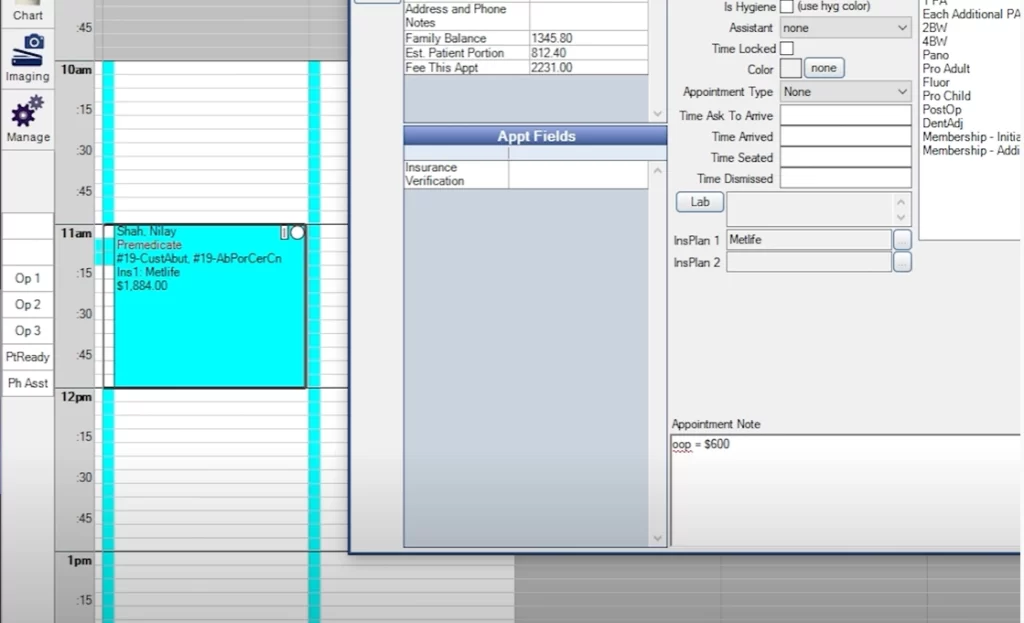
Sometimes this changes, for instance, when the patient comes in and the doctor is working on restorative – but they were informed it could require a root canal in advance, and then the doctor decides to start the root canal the same day.
This change needs to be communicated to the front desk team somehow. Whatever system you use, you need a way to communicate changes to the front office team.
In my practice, we’re using Teamio to chat with my team at the front – especially if I need something or need to tell them something right away.
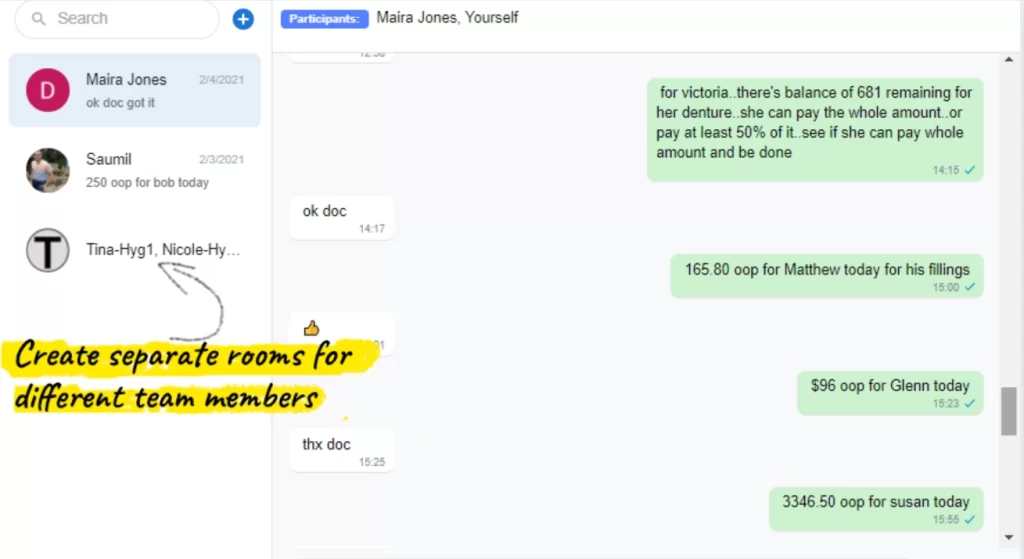
I do want to bring up an important point here since we’re talking about collecting patient copays.
Verbiage matters.
What you say and more importantly, HOW you say it to the patients matters big time.
When your patient is checking out, and your team members says something along the lines of..”ok..umm..i think your copay today is $30..” – this raises red flags in the patient’s mind.
Put yourself in the patient’s shoes, you lose confidence in that personnel helping you – in most patient’s minds, our front desk is supposed to know everything about their dental insurance – that’s just the reality.
This is not an example I just made up. When I did my startup, I hired and let go of three different “experienced” dental receptionist in the first 4 months.
I learned the hard way. After that, I changed everything because I never wanted to go through that again.
So the confidence that I’m referring to comes from having all the information on hand to be able to tell your patients what their financial obligation is going to be.
Which brings me to my next point..
Dental Insurance Verification
All patients on schedule should have their insurance verified
Whether it’s existing or new patients – every patient should have their insurance verified.
I understand there will be some exceptions in case where the new patient told your team over the phone that they don’t have the insruance card yet, and they’ll bring it in during their visit.
Or the emergency walk in who hands you their insurance info when they first come in with tooth ache.
Patients on schedule coming in for work with PreAuth Approval on file
If you’ve got patients coming in today who you’ve sent out preauthorization for work they need done – and you’ve got the approval on file – you just need to make sure they have enough insurance $ remaining on their plan to cover their appointment today.
This is especially true if you’ve sent the patient out to a periodontist, for example, and they did some work such as sinus lift, grafting, etc.- and patient happens to have a very small max of lets say $1000 on their plan.
And now the patient comes back to your practice, and the doctor is supposed to start a crown on #14, your team assumes there’s coverage because there’s an approved PreAuth on file.
If the patient had gone to the periodontist AFTER your preauth was approved, and assuming the periodontist billed the patient’s insurance for their work, most likely that patient is not going to have much benefits left on their plan or maybe they’re maxed out already.
But your team needs to know how much is remaining on their plan as of the day they’re coming in and make sure the perio work is processed.
If this isn’t done, then even though you have an approved PreAuth on file for that crown, there isn’t any benefits left so the insurance will not pay any benefits.
This simple process leads to many headaches because your team, being unaware of the patient’s benefits – tell the patient your estimated insurance coverage is so and so for the crown, but when the claim comes back, insurance doesn’t pay because they’re maxed out.
Then, of course, you’ll have to bill the patient for the rest.
For most patients this is okay, they’ll pay.
But you know there are going to be few that will say “you told me insurance was going to cover this and now you tell me they’re not paying” – they’ll create drama, you know every practice has these patients.
So to avoid these situations from happening, we put in the extra work at the beginning so there’s no issues with patients paying because we can tell them ahead of time the full payment they’re going to owe.
Let’s go on to the next part – which is keeping a productive schedule for the upcoming weeks.
Schedule for the next 2 weeks
Keep a productive schedule for upcoming weeks.
Instead of focusing on the end of the month, or the next month, I like to focus on the next 2 weeks.
You should have some sort of production goal for the days you’re in office.
If there are holes in the schedule within the 2 weeks, filling those spots become the #1 priority for your team to meet your production goals for that day.
This is true for hygiene schedule as well.
I used to look far out into the end of the month and then sometimes the next month – but then I realized further out the patient appointments are from the time they schedule, higher the chance of them cancelling.
Because when an appointment is made a month out – things always come up for patients, so I focus on just the next two weeks.
I used to do this manually where we wrote out production goals for each day we’re in the practice, as well writing down what was actually scheduled on those days.
Now we’ve switched over to using Teamio where we can set up provider goals for different providers for each day they’re in the practice.
And now with a quick glance, my team is able to see quickly which days in the next two weeks they need to focus on for filling holes.
If they see a green thumbs up, that means we’ve scheduled to goal – and if there’s no green thumbs up, they can see how much they still need to put
on the schedule to meet the goal.
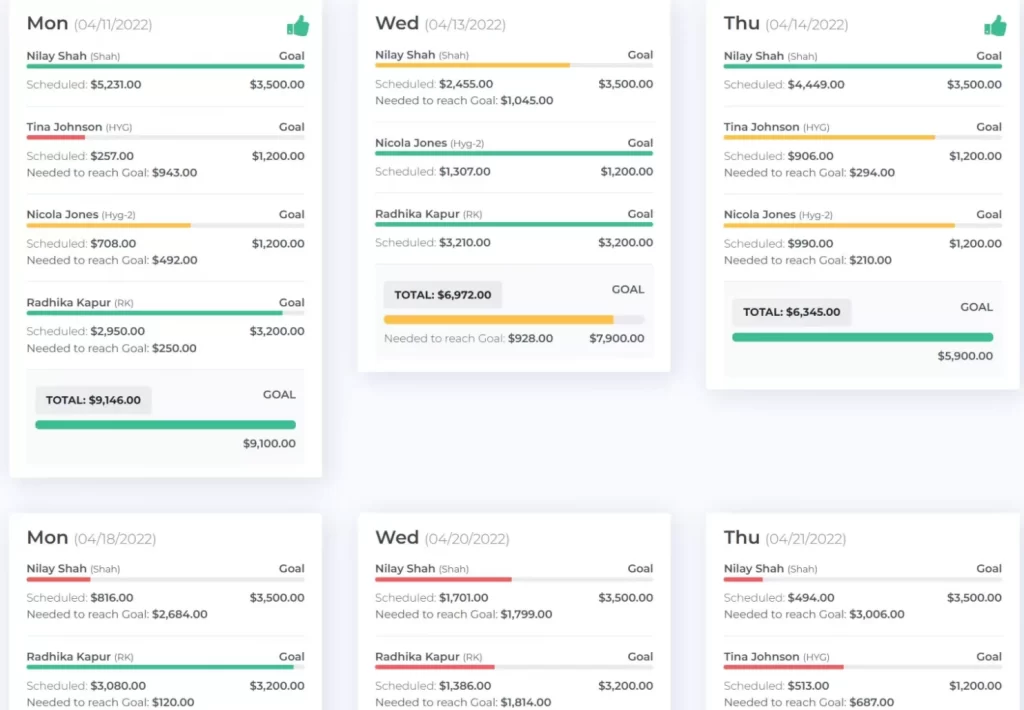
Let’s continue onto the next thing for our daily flow.
Check your electronic Claims software Dashboard for Rejected / Kicked back claims
From the claims that were sent in a batch from the night before, DentalXChange will show us if any claims are rejected because maybe it has wrong information that they can’t find the subscriber, or if the plan is no longer effective.
This should be checked earlier in the day because if the plan is no longer effective – then your team needs to immediately reach out the patient to get the new insurance information.
Yes, this will happen. Patients will forget to give you their new insurance info, so make sure this step is done on a daily basis.
Pending PreAuthorizations
You need to have a system where you know a Pre-Authorization has been sent for a patient – and whether or not it’s been received when you’re just looking at the schedule.
I”ll show you a simple system I use in my practice using Appointment Colors in Open Dental. You should think about creating something similar in whatever practice management system you’re using if you’re not using Open dental.
So when a patient needs work and we decide to send out a Pre-Authorization for the work, we always preschedule the patients appointment about two weeks out because we know usually we can get the Pre-Auth back by that time.
So then, we change that future appointment color to indicate a Preauth was sent out, but not received yet.
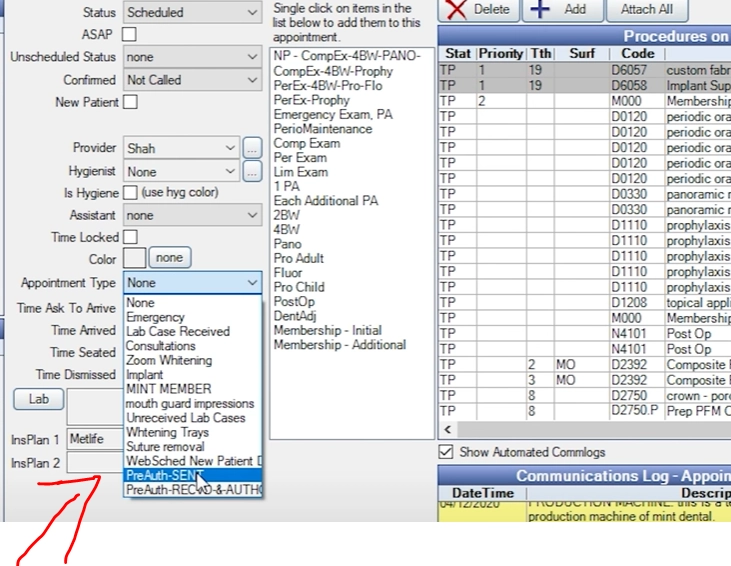
Everyday, your team checks for the week and next week to see if the apt color isn’t green, then you need to follow-up to make sure the insurance has all the info on file to process it and how long it’s going to take to process.
Of course, once the preauth comes in, and it’s marked in your system as received, you need to change the apt color for the patient to indicate the PreAuth is received.
This is ALL to make sure you’re going to get paid for your work you do on your patients.
Patient Check-out process
- Make sure procedures that are attached to the appointment are actually correct
- Before marking the patient’s appointment complete, view tx plan to confirm the appointment out-of-pocket(OOP) for the patient.
- Generate the claim – make sure correct procedures are attached to the claim.
- Collect OOP from the patient for the appointment
- When marking payment made in the patient’s account: select procedures completed today and then assign the payment towards those procedures.
- Make sure the patient has their NEXT appointment set up for additional work if any left in the tx plan.
- If the patient doesn’t schedule the appointment for a procedure in their treatment plan, always ask to follow-up and put in a reminder for your team to follow-up
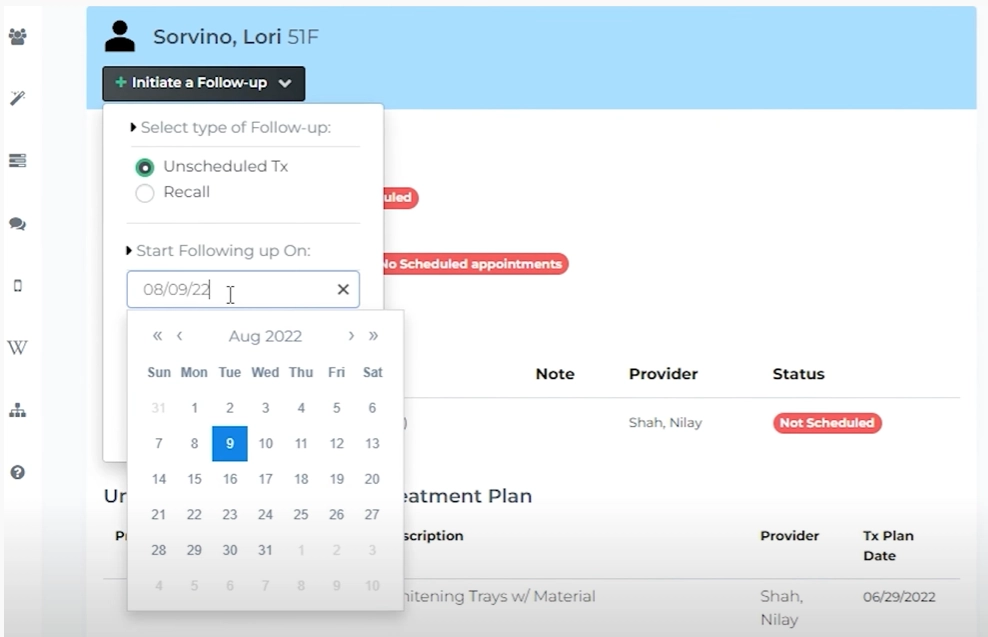
- if they no longer have any treatment left in their plan, then they should have their next recall appointment set up.
End of day: (5 Minute process after seeing your last patient)
Batch send all claims that have already been generated from end of each appointment during checkout.
For Front Desk Team Member:
- Collect all insurance checks entered throughout the day
- Go over with owner/manager about payments that were less than expected and decide whether:
- you need to resubmit the claim with more documentation (and make sure to track when to follow-up) or
- if you’re writing-off the unpaid amount, or
- Billing the patient for the unpaid insurance amount
- Collect all Credit card receipts, EFTs, and 3rd party payments/receipts
- For Owner/Manager along with a FD team member:
- Run a Payment Report
- Make sure the checks match up with what’s on the report
- Match up CC receipts, EFT payments and other 3rd party payment receipts
- Run a Daily Adjustment Report, so you can see where discounts were applied through the day
The manager / Owner doctor needs to go over this on a DAILY basis – this will make sure daily errors don’t add up to weeks and then to months and then to years!!
From the schedule perspective, that’s the flow throughout the day for our team in my practice.
Remember, everything I’ve discussed so far is only part of the daily routine.
Of course, there are other things to consider which I haven’t discussed that should also be done throughout the day.
Outbound Follow-ups
I refer to these tasks as the “outbound efforts”.
On a daily basis, there must be some time set aside – whether it’s 15 minutes, 30 minutes or an hour – one or more members of your team should be dedicating their time to this task!
The question we’re asking is – what are some things we need to do on a consistent basis that
- minimizes the holes in the schedule
- prevent patients falling through cracks – whether it’s for recall or for unscheduled treatment
- keeps our Aging reports in check (minimize money owed to the practice or keeping the collections as close to our actual average net adjusted production)
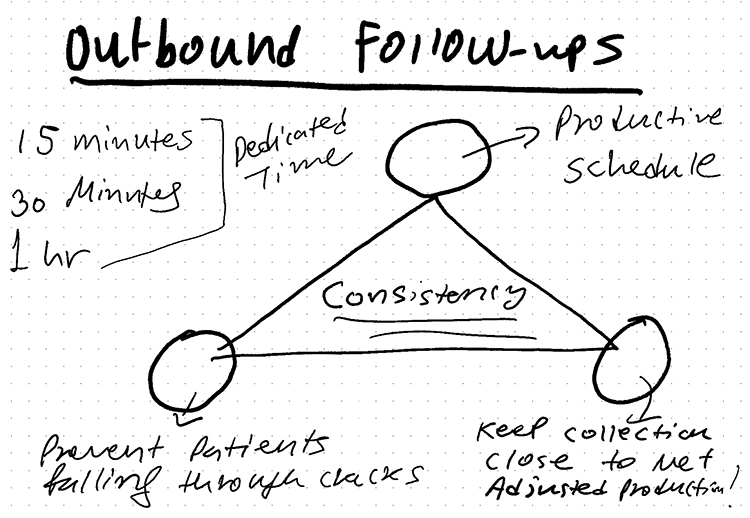
To be more specific, the tasks that should be done on a consistent basis include the following:
- following up on patients with unscheduled treatment and enforcing the consistency
- following up on patients who are overdue for recalls: Text and emails are great, but what about the overdue patient that you haven’t seen in more than a year? These patients need more attention – a phone call from your front desk.
- if this isn’t done consistently, you should run your overdue recall report and go back 1-2 years – you’ll be shocked at the number of patients that haven’t come in (the same patients you paid $$$ in your marketing campaign to bring in the first place) – now these patients are just leaving through the back door
- following up on Outstanding claims that are more than 30 days old (having a system in place for follow-up for individual claims that require more than one or two follow-ups)
- following up on Patients with balances (these should be minimized from the get go) – everyone hates to make these phone calls to collect balances.
Consistency is the most important in all the things I just mentioned.
Well that’s it for today, I hope you found this video helpful.
Leave your questions in the comments below. Id love to hear from you if you’re doing things differently in your practice that’s working for you.